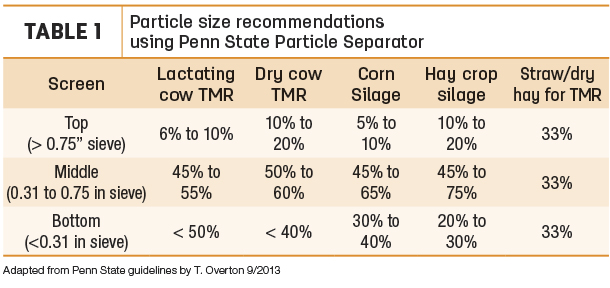Treating cows right for those critical weeks before and after calving leads to more milk, better reproduction and fewer headaches throughout the lactation.
Tom Overton, professor of dairy management and director of PRO-DAIRY at Cornell University, believes dairies are rising to the challenge of catering to transition cows’ unique needs, yet there are some overlooked opportunities that continue to exist.
“There are a lot of dairies that do a great job of disease management, but we still have a significant opportunity to improve,” he says.
Overton outlines the top 10 things to do for healthy and productive transition cows:
1. Manage macromineral nutrition/dietary cation-anion difference (DCAD) of dry cows, especially in the last two to three weeks before calving to prevent clinical and subclinical hypocalcemia. “We know we have a lot of subclinical hypocalcemia, even in herds with low clinical hypocalcemia.” These are the cows that “go down in blood calcium and stay down,” Overton says.
According to Overton, dietary management prior to calving is the most effective way of preventing hypocalcemia afterward. Changing only the forage base is a “passive approach,” he adds. “It can prevent milk fever on the dairy, but it’s probably not going to do much for the subclinical side.”
Address DCAD concerns by minimizing or avoiding high-potassium forages while supplementing anions like chloride or sulfur-containing supplements. Achieve a low-calcium diet by using a calcium binder to decrease absorption of the mineral.
He further stresses the importance of providing a consistent ration with the correct particle length and moisture to prevent sorting. Monitor urine pH to gauge success. (See sidebar for five DCAD strategies for close-up dry cows below.)
2. Control energy intake in both far-off and close-up cows – not too little, not too much. Feeding the appropriate amount of energy for these cows is a delicate balance. Overton notes, “We don’t steam them up like we did back in the day, but I like to see a little more energy for pre-fresh.”
During the far-off time, he emphasizes feeding less than 13 percent starch for a low-energy diet. When close-up heifers and older cows are fed the same ration, he advises 16 to 18 percent starch for a low to moderate energy level, supplementing rumen-undegradable protein (RUP) and an appropriate mineral mix, particularly for potassium, magnesium, sodium, sulfur, chloride, calcium, vitamin D, vitamin E and trace minerals.
Overton acknowledges feeding a one-group ration is sometimes the most practical option. If that is the situation, he suggests low to moderate energy, with starch at 14 to 16 percent, along with similar RUP and vitamin and mineral supplementation to that aforementioned for the close-up ration.
3. Supply enough metabolizable protein (MP) before calving. Overton says this can be accomplished by feeding bypass protein sources and balancing for amino acids.
4. Get the feeding management right, every day. “This one is huge,” Overton says, underscoring the importance of consistent feed mixing and delivery. Minimize sorting with particle length no greater than 1.5 inches for straw and hay, and target 46 to 48 percent moisture by adding water if necessary.
Particle length is an area in which Overton sees opportunity for improvement. “About 25 percent of herds are doing a good job, about 50 percent are in the middle, and 25 percent are still really coarse with these diets,” he says. (See Table 1. Particle size recommendations using Penn State Particle Separator.)

5. Clean and comfortable housing and fresh water. Not to be overlooked are ample access to water, stalls and bunk space for transition cows, along with clean, well-groomed stalls sized appropriately to the animals.
6. Manage social interactions/hierarchy. Pen changes can lead to transition cow stress. Consider this when commingling heifers and cows or introducing animals to new groups. Avoiding overcrowding transition cows can be helpful here. Overton notices improvements on the dairies he works with, saying, “People are really paying a lot more attention to stocking density.”
7. Manage heat stress. Research shows cooling dry cows is a worthy investment. “Heat stress not only affects the cow, but it also affects the in-utero calf,” Overton says. Calves born to heat-stressed dams tend to have lower birthweights and weaker immune systems, as well as poorer feed efficiency and decreased milk production during the first lactation. These detrimental effects are not limited to the hottest regions of the country. “Even in New York and Wisconsin, it’s an opportunity,” he adds.
8. High-quality forage and fermentable diets for fresh cows. Studies show higher dry matter intakes (DMIs) among cows fed BMR corn silage compared to conventional corn silage during the first few weeks after calving, as well as higher fat-corrected milk (FCM) levels.
9. Strategically use feed additives/specific nutrients. Overton further notes certain nutrients and feed additives have been shown to improve transition cow health. Among them, choline (for helping the liver export fat), amino acids (for performance and immunity), chromium-propionate (for energy metabolism, immune function and DMI) and improved forms of trace minerals (hydroxy and organic forms for decreased oxidative stress, improved milk yield and immune function). Monensin and yeast cultures also show benefits in better post-calving performance.
10. Implement cow and herd-level monitoring programs. Whether seeking to make a diagnosis or treatment on an individual animal or taking representative samples from groups of cows, valuable information can be derived to identify and manage transition cow health. Many tools exist for monitoring nutritional and non-nutritional-related factors, such as blood ketone testing, rumination monitoring, testing urine pH and looking for variations in milk yield. Overton says to watch for deviation from the norm.
“Most of the industry works on averages, but the opportunity is in looking at the variations,” he says. With these 10 steps in mind, dairy producers can fine-tune the transition cow program for even greater levels of health and performance.
Overton concludes, “We can have really good control of clinical disease, but we may still have stuff going on underneath the hood.” ![]()
Tom Overton presented on “10 Steps to a Healthier Transition” during the 2018 PDPW Herdsperson Conference held Nov. 1, 2018 in Arlington, Wisconsin.

-
Peggy Coffeen
- Editor
- Progressive Dairy
- Email Peggy Coffeen
Five major strategies for application of DCAD for close-up dry cows
1. Feeding low-potassium and low-sodium forages and feeds to close-up dry cows
- Calculated DCAD +10 mEq per 100 grams of dry matter; urine pH 8.3 to 8.5
2. Feeding low-potassium forages along with partial use of anionic supplement in close-up ration or one-group dry cow ration
- Calculated DCAD 0 mEq per 100 grams of dry matter; urine pH 7.5
3. Feeding low-potassium forages along with full use of anionic supplement in close-up ration or one-group dry cow ration
- Calculated DCAD -10 to -15 mEq per 100 milligrams of dry matter; urine pH 5.5 to 6 – need to monitor weekly and adjust DCAD supplement if out of range.
4. Need to also supplement magnesium (dietary target about 0.45%) during close-up
5. Recommended supplementing calcium (0.9% to 1%, if low-potassium only; 1.4% to 1.5% if feeding a full anionic diet)











